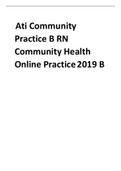College aantekeningen
Key themes Innovative and Sustainable Regions: lectures, tutorials and articles
This document contains all information needed! The notes on the lectures 1-5 are elorated with notes on the related articles that we needed to read. Also, the notes on tutorials 1-2 are provided. Besides, screenshots of the associated PowerPoints are implemented.
[Meer zien]








